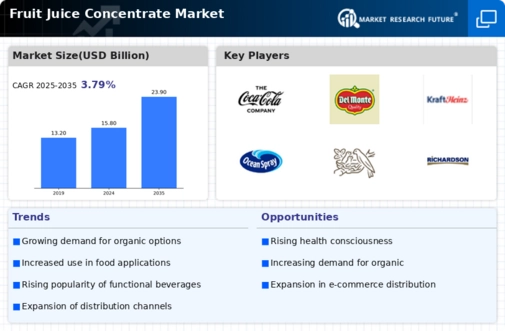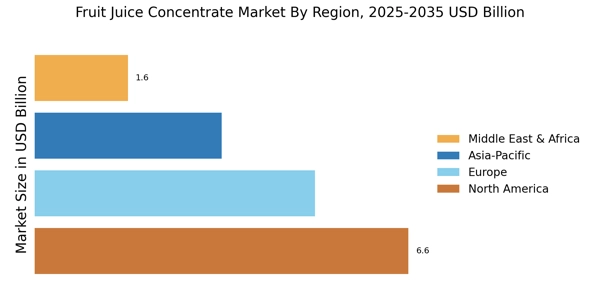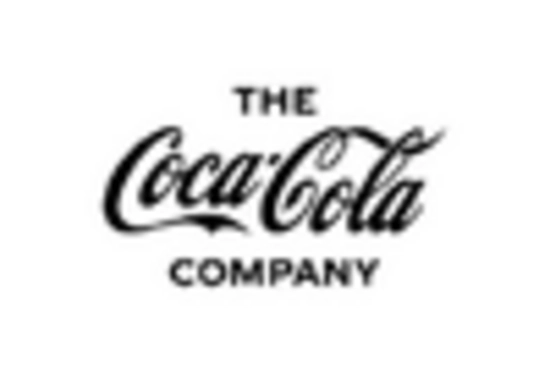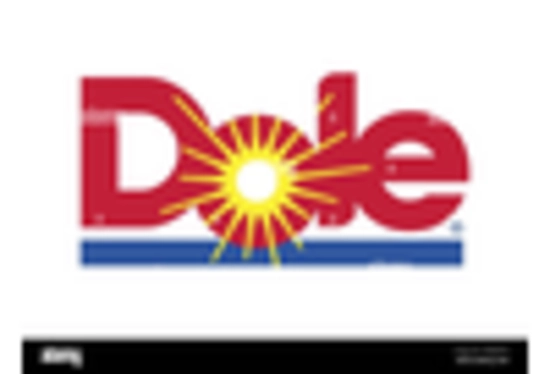Growing Beverage Industry
The expansion of the beverage industry is likely to serve as a catalyst for the Fruit Juice Concentrate Market. With the rise in popularity of smoothies, functional drinks, and ready-to-drink beverages, fruit juice concentrates are increasingly being utilized as key ingredients. Market data suggests that the beverage sector is projected to grow at a compound annual growth rate of around 8% over the next five years. This growth is expected to drive demand for fruit juice concentrates, as manufacturers seek to enhance flavor profiles and nutritional content in their products. Consequently, the Fruit Juice Concentrate Market stands to benefit from this trend, as it aligns with the evolving preferences of consumers who are seeking convenient and health-oriented beverage options.
Innovations in Processing Technology
Advancements in processing technology are poised to significantly impact the Fruit Juice Concentrate Market. Techniques such as cold pressing and flash pasteurization are being adopted to preserve the nutritional integrity and flavor of fruit juice concentrates. These innovations not only enhance product quality but also extend shelf life, making them more appealing to both manufacturers and consumers. Furthermore, the integration of technology in production processes can lead to cost efficiencies, potentially lowering prices for end consumers. As a result, the Fruit Juice Concentrate Market may witness an influx of new products that leverage these technologies, thereby attracting a broader customer base and increasing market penetration.
Rising Demand for Natural Ingredients
The increasing consumer preference for natural and organic products appears to be a driving force in the Fruit Juice Concentrate Market. As health-conscious consumers seek alternatives to artificial flavors and preservatives, the demand for fruit juice concentrates made from 100% natural ingredients is likely to rise. According to recent data, the market for natural food products has seen a growth rate of approximately 10% annually, indicating a robust trend towards clean label products. This shift not only influences purchasing decisions but also compels manufacturers to innovate and reformulate their offerings to align with consumer expectations. Consequently, the Fruit Juice Concentrate Market is expected to adapt by enhancing product transparency and sourcing high-quality raw materials, thereby catering to the evolving tastes and preferences of consumers.
Increased Focus on Health and Wellness
The heightened awareness surrounding health and wellness is influencing consumer choices, thereby impacting the Fruit Juice Concentrate Market. As individuals become more informed about the benefits of vitamins and antioxidants found in fruit juices, the demand for nutrient-rich concentrates is likely to increase. This trend is further supported by the rise in health-related campaigns and initiatives promoting fruit consumption. Market Research Future indicates that products fortified with vitamins and minerals are gaining traction, suggesting a shift towards functional food products. As a result, the Fruit Juice Concentrate Market may experience a surge in product development aimed at meeting these health-oriented demands, ultimately leading to a more diverse product range.
Sustainability Initiatives in Production
Sustainability has emerged as a critical consideration in the production processes of the Fruit Juice Concentrate Market. With growing concerns about environmental impact, manufacturers are increasingly adopting sustainable practices, such as sourcing fruits from certified organic farms and utilizing eco-friendly packaging. This shift not only appeals to environmentally conscious consumers but also aligns with regulatory trends favoring sustainable production methods. Data indicates that companies implementing sustainability initiatives can enhance their brand image and customer loyalty, which is vital in a competitive market. As such, the Fruit Juice Concentrate Market is likely to see a rise in products that emphasize sustainability, thereby attracting a segment of consumers who prioritize eco-friendly options.


















Leave a Comment